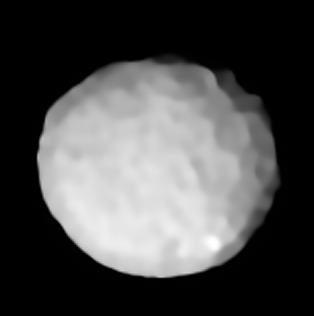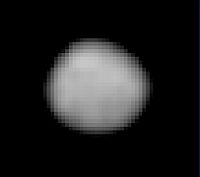
2 Pallas
Pallas (minor-planet designation: 2 Pallas) is the third-largest asteroid in the Solar System by volume and mass. It is the second asteroid to have been discovered, after Ceres, and is a likely remnant protoplanet. Like Ceres, it is believed to have a mineral composition similar to carbonaceous chondrite meteorites, though significantly less hydrated than Ceres. It is 79% the mass of Vesta and 22% the mass of Ceres, constituting an estimated 7% of the mass of the asteroid belt. Its estimated volume is equivalent to a sphere 507 to 515 kilometers (315 to 320 mi) in diameter, 90–95% the volume of Vesta.
This article is about the asteroid. For other uses, see Pallas (disambiguation).Discovery[1]
28 March 1802
(2) Pallas
Palladian (/pæˈleɪdiən/)[5]
219 yr
2.13 AU (319 million km)
2.77 AU (414 million km)
0.2302
4.611 yr (1,684.0 d)
40.6
0° 12m 46.8s / day
34.93°
(34.43° to invariable plane)[7]
172.9°
7 March 2023
310.9°
1.2 AU (180 million km)
2.7709176 AU
0.2812580
33.1988686°
0.21[b]
(8.3±0.2)×105 km2 (2020)[c]
(7.06±0.3)×107 km3 (2020)[9]
324 m/s[9]
7.8132 h[14]
65 m/s[c]
84°±5°[10]
6.49[17] to 10.65
4.13[15]
0.629″ to 0.171″[f]
During the planetary formation era of the Solar System, objects grew in size through an accretion process to approximately the size of Pallas. Most of these protoplanets were incorporated into the growth of larger bodies, which became the planets, whereas others were ejected by the planets or destroyed in collisions with each other. Pallas, Vesta and Ceres appear to be the only intact bodies from this early stage of planetary formation to survive within the orbit of Neptune.[18]
When Pallas was discovered by the German astronomer Heinrich Wilhelm Matthäus Olbers on 28 March 1802, it was considered to be a planet,[19] as were other asteroids in the early 19th century. The discovery of many more asteroids after 1845 eventually led to the separate listing of "minor" planets from "major" planets, and the realization in the 1950s that such small bodies did not form in the same way as (other) planets led to the gradual abandonment of the term "minor planet" in favor of "asteroid" (or, for larger bodies such as Pallas, "planetoid").
With an orbital inclination of 34.8°, Pallas's orbit is unusually highly inclined to the plane of the asteroid belt, making Pallas relatively inaccessible to spacecraft, and its orbital eccentricity is nearly as large as that of Pluto.[20]
The high inclination of the orbit of Pallas results in the possibility of close conjunctions to stars that other solar objects always pass at great angular distance. This resulted in Pallas passing Sirius on 9 October 2022, only 8.5 arcminutes southwards,[21] while no planet can get closer than 30 degrees to Sirius.
Satellites[edit]
A small moon about 1 kilometer in diameter was suggested based on occultation data from 29 May 1978. In 1980, speckle interferometry suggested a much larger satellite, whose existence was later refuted a few years later with occultation data.[53]
Exploration[edit]
Pallas itself has never been visited by spacecraft. Proposals have been made in the past though none have come to fruition. A flyby of the Dawn probe's visits to 4 Vesta and 1 Ceres was discussed but was not possible due to the high orbital inclination of Pallas.[54][55] The proposed Athena SmallSat mission would have been launched in 2022 as a secondary payload of the Psyche mission and travel on separate trajectory to a flyby encounter with 2 Pallas,[56][57] though was not funded due to being outcompeted by other mission concepts such as the TransOrbital Trailblazer Lunar Orbiter. The authors of the proposal cited Pallas as the "largest unexplored" protoplanet with the main belt.[58][59]



![Objects considered for dwarf planet status under the IAU's 2006 draft proposal on the definition of a planet.[60] Pallas is second from the right, bottom row.](http://upload.wikimedia.org/wikipedia/commons/thumb/7/72/Iau_dozen.jpg/200px-Iau_dozen.jpg)